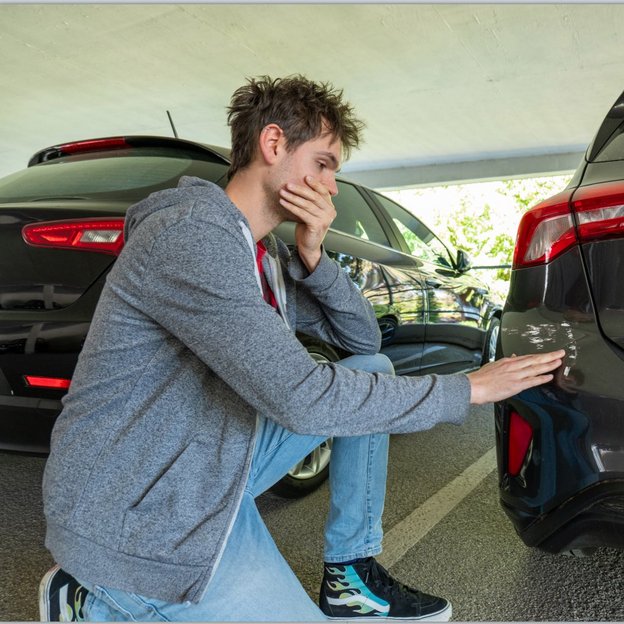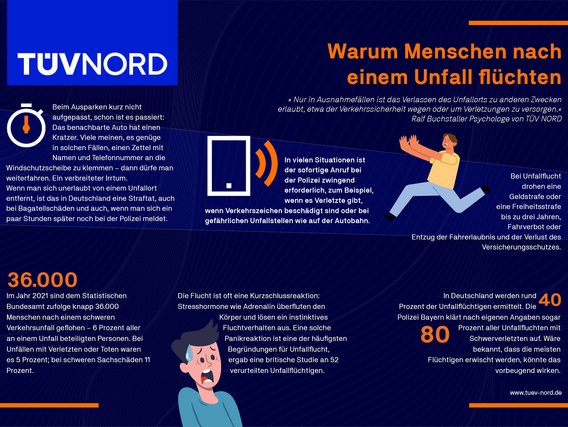Why people run away after an accident
Mobility: Sich unerlaubt vom Unfallort zu entfernen, ist ein Massendelikt. Die Gründe sind vielfältig. Manche wissen nicht, was sie tun.

Mobility: Sich unerlaubt vom Unfallort zu entfernen, ist ein Massendelikt. Die Gründe sind vielfältig. Manche wissen nicht, was sie tun.

Not paying attention when pulling out of a parking space and it happens: The neighboring car has a scratch. Many people think that in such cases it is enough to stick a note with your name and telephone number on the windshield - then you can drive on. “A common misconception,” warns Ralf Buchstaller from the Medical-Psychological Institute of TÜV NORD in Hamburg. This is because you are driving away from the scene of the accident without permission. “In Germany, this is a criminal offense,” the psychological expert clarifies, ”even in the case of minor damage and even if you contact the police a few hours later.”
In many situations, it is essential to call the police immediately anyway, says Buchstaller: for example, if there are casualties, if traffic signs are damaged or in the case of dangerous accident sites such as on the highway. In the case of a minor scratch, on the other hand, it may be sufficient for the parties involved in the accident to exchange data and report it to their insurance company - as long as all parties involved agree on who is at fault.
However, you may have to wait at the scene of the accident for the injured party to leave their personal details. The waiting time is not standardized; it depends on the circumstances, but should not be less than half an hour, even for minor damage. However, psychologist Buchstaller reminds us that if no one turns up, we must report the incident to the police immediately. “Only in exceptional cases is it permitted to leave the scene of the accident for other purposes, such as road safety or to treat injuries.” This applies to everyone involved in an accident, even if they were on foot or on a bike.
Severe penalties for hit-and-run accidents
Hit-and-run drivers face a fine or a prison sentence of up to three years, a driving ban or disqualification from driving and loss of insurance cover. Nevertheless, hit-and-run is a mass offense, and not just if you include petty offenses. According to the Federal Statistical Office, almost 36,000 people fled after a serious traffic accident in 2021 - six percent of all people involved in an accident. For accidents with injuries or fatalities, the figure was five percent; for serious property damage, eleven percent. The number of people fleeing after minor or unreported damage is estimated to be many times higher.
Data from the USA shows similar rates. For example, in Boston between 2009 and 2012, six percent of collisions between motorized vehicles and cyclists resulted in fleeing. After accidents that ended fatally for pedestrians involved, as many as 18 to 20 percent of motorists fled.
According to the US studies, hit-and-run accidents were more likely to occur at night and on weekends, as well as when drunk and without a valid driver's license. Young men were disproportionately represented. In contrast, a hit-and-run was less common if the victim was a child or of advanced age. This shows that various factors can play a role: Victims who appear particularly helpless are apparently more likely to be struck by their conscience. And in the dark, those involved probably think they have a better chance of getting away unseen.

German Traffic Court Conference recommends reform
In Germany, around 40 percent of hit-and-run accidents are investigated, and even more in the case of accidents involving fatalities and injuries. According to the Bavarian police, as many as 80 percent of all hit-and-run accidents with serious injuries are cleared up. If it were known that most fugitives are caught, this could have a preventative effect. A study in more than 3,000 US districts found that a more effective justice system would have a considerable signal effect. Proposals to decriminalize hit-and-runs without personal injury have been met with corresponding criticism: Experts fear this would lower the inhibition threshold.
A working group of the German Traffic Court Conference also voted against decriminalization at the beginning of 2024. It also recommended reforming the regulations for those involved in accidents, including setting a minimum waiting time and setting up a central reporting office, combined with the option of reporting an accident within 24 hours without penalty. Up to now, late reporting to the police has at most mitigated the penalty, and only in the case of material damage.
The innovations could make it easier for people who have escaped an accident to change their mind afterwards. This is because flight is often a short-circuit reaction: stress hormones such as adrenaline flood the body and trigger instinctive flight behavior. Such a panic reaction is one of the most common reasons for hit-and-run accidents, according to a British study of 52 convicted hit-and-run drivers. According to their own statements, most of them acted out of self-protection - either in panic mode or to avert possible consequences, for example if they were driving without a license or were drunk. Others claimed that they had not noticed the accident or had thought it was just a trivial matter that did not need to be reported.
Many convicted hit-and-run drivers in Belgium expressed similar views. The Institute for Road Safety there interviewed 853 of them, most of whom were men and most of whom were no older than 25. The most common excuse: I thought it was an animal. In 42 percent of cases, the fleeing person was under the influence of alcohol or other drugs. This makes it difficult to make a rational decision, explains traffic psychologist Ludo Kluppels, especially in the first few seconds after the accident, when emotions such as fear, shame and guilt prevail. Although most people have the necessary self-control to act responsibly, not everyone does.
“With a small group, it is not an overwhelming flood of emotions that leads to the wrong decision, but a lack of emotion,” reports Kluppels. They lack a moral compass; they don't care about other people, rules and laws, but only about their own interests - escaping punishment. People generally have a strong urge to avoid unpleasant things. But they usually resist the impulse because they don't want to be bad people and escaping would violate laws, social norms and moral values. “If they still behave incorrectly, a cognitive dissonance arises between aspiration and reality,” explains Ralf Buchstaller, who holds a doctorate in psychology. “To resolve the contradiction, they look for excuses or justifications.” This may ease their conscience. But they still face punishment.
Founded over 150 years ago, we stand for security and trust worldwide. As a knowledge company, we have our sights firmly set on the digital future. Whether engineers, IT security experts or specialists for the mobility of the future: in more than 100 countries, we ensure that our customers become even more successful in the networked world.